Types of gas mixtures in cylinders for a gas stove
Have you ever tried to detect a gas leak in the kitchen by smell? What if there is no smell or it is difficult to detect? Agree that those who understand the main differences between gas mixtures and know how to identify them feel more confident. It is important to know what liquefied gas is in cylinders and how it will behave if the integrity of the gas pipeline is violated. This is a security issue.
Each type of fuel has its own characteristics. Specific heat of combustion, color, smell, spontaneous combustion temperature - all these are signs by which we identify a substance. An important parameter is molar mass. The distribution of gas during a leak depends on this value: it will accumulate below, filling the basement, or, conversely, it will rise.
The ability to understand balloon mixtures is the key to proper operation and the absence of fatal errors during replacement and disposal. In addition, knowledge of the theory will help you make an informed choice when purchasing. And this is already half the battle.
The content of the article:
Natural or liquefied - what's the difference?
When choosing a fuel source, the user may come across two concepts: natural gas and liquefied gas. The first, in most cases, is transmitted through urban backbone networks. Much less often it can be purchased in a compressed state in containers.The second is the traditional composition for propane and butane cylinders.
Characteristics of natural gas
The main component is methane. It accounts for almost no less than 70%.
The remaining parts are distributed among heavy hydrocarbons:
- propane;
- butane;
- ethane;
- pentane.
In addition, the composition includes hydrogen, nitrogen, carbon dioxide and a small amount of hydrogen sulfide. It is important to know that natural gas is odorless and colorless. Therefore, it is customary to enrich natural gas in cylinders odorants – substances with a pungent odor.
You don't have to sniff to detect a leak. Due to its volatility, the compound instantly spreads indoors and quickly attracts attention.
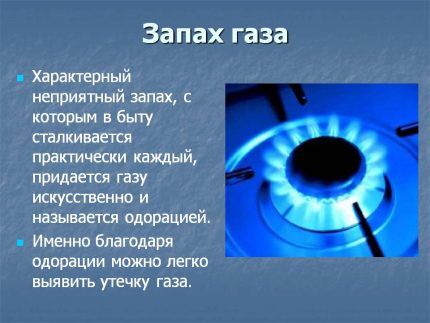
The most common odorant is ethanethiol, which smells like rotten or rotten eggs. In large quantities this compound is toxic. In low concentrations, characteristic of the classic composition of a household gas mixture, it is absolutely harmless.
Advantages of liquefied gas
The liquefied gas is propane and butane, mixed in different proportions. Under high pressure, these carbons turn into liquid and noticeably decrease in volume. The reverse process is possible with increasing temperature - heating entails expansion of the substance. Therefore, cylinders for liquefied hydrocarbon gases are manufactured strictly in accordance with GOST standards and are filled no more than 85%.
The undeniable advantage of propane-butane gas is its lightness.A cylinder filled with such a mixture will be several times lighter than a similar container with methane.
Other advantages:
- environmental Safety;
- a strong specific odor is a useful indicator of leakage;
- low cost.
Properly configured plate connected to the cylinder with hydrocarbon gas, will work without soot, and will produce even streams of burning fuel.
Winter and summer mixtures
Since only one 5-liter cylinder is allowed in residential premises, larger containers are installed outside the home. Accordingly, the climatic conditions during use can be anything. Taking this factor into account, gas compositions are created for the warm and cold seasons, which are described in more detail Here.
What is the difference between the seasonal versions?
Inside the cylinder, liquefied gas is in two states of aggregation: liquid and gaseous. The intensity of filling the gas duct with the gaseous fraction directly depends on the temperature: in warm conditions the indicator is higher than at low temperatures.
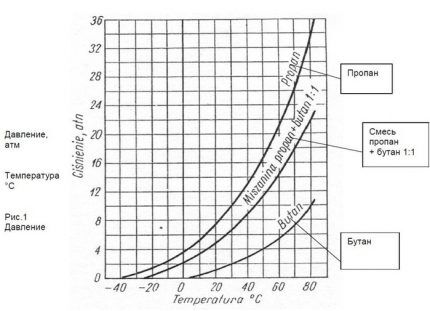
Correction of this situation is carried out by changing the proportions of propane and butane. The first is capable of evaporating at 42 degrees below zero. The second loses this ability immediately after crossing the zero mark.
Therefore, in winter versions, the volume of propane increases. In summer, on the contrary, it decreases. This approach makes it possible to reduce the cost of summer versions due to cheaper butane and ensure the efficiency of winter ones.
Calculation of proportions taking into account climate
When determining the recommended proportions, the central part of Russia was taken as the starting point. The minimum propane content for the winter version is limited to 70%. In the summer version, 50 percent content is acceptable.
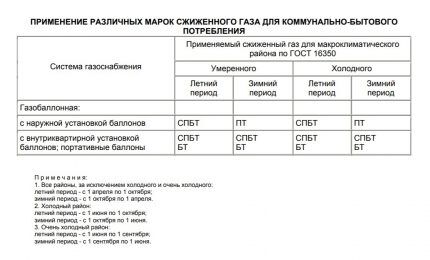
The composition for other regions is carried out taking into account the distance from the middle zone and climatic conditions. This must be done by specialists from licensed organizations.
Universal option for any temperature
Correct functioning of portable gas systems over a wide temperature range is typical for the combination of propane, isobutane and butane. Having different combustion temperatures, these substances made the complex composition as versatile as possible.
Painting and marking of gas cylinders
Surprisingly, the world has not yet come to a unified labeling system for gas cylinders. Therefore, when choosing a fuel source abroad, it is necessary to study local regulations. In Russia, all containers with gas mixtures used for cooking on the stove have a white transverse inscription on a plain red background.
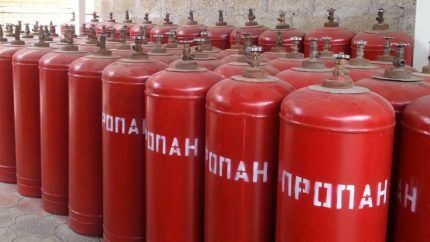
All other information is on a metal plate - a kind of product passport. This is the service life, serial number, empty container weight, date of manufacture and next certification, manufacturer’s trademark, test pressure.
Painting and marking standards are the same for methane and propane-butane mixtures - only red cylinders with white lettering are suitable for use in the kitchen. Other colors may mean that the container is filled with nitrogen, argon, ammonia, helium, or freon.
How to detect a leak?
The difference between methane and propane-butane mixture leaks is the smell. But in both cases, the stench will make itself felt first.
To detect the penetration of both trains into the airspace, 4 methods are suitable:
- Definition by hand. Household gases are colder than air. By running your hand over the flange connections and joints of gas pipeline elements, you can easily feel the emanating chill.
- Using soap solution. Bubbles that appear on the treated surface indicate a problem.
- Installation of a stationary sensor. Models that provide not only a digital signal in the form of instrument readings, but also an audio signal are preferred.
- Measurement with a portable device.
The method for measuring the concentration of a harmful compound in the air using portable sensors depends on the composition of the gas in household cylinders installed in the kitchen or outside the home.
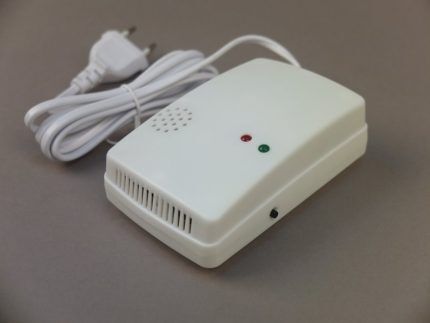
When measuring propane/butane leakage, the device must be installed at the lowest point in the room. The heavy mixture will primarily fill the space near the floor.
The situation with methane is the opposite - this gas is two times lighter than air. Therefore, as it evaporates, it will move upward. Accordingly, measurements will have to be taken from the ceiling.
How to calculate the fullness of a cylinder?
The filling of the cylinder with the mixture can be easily determined by its weight. To do this, you need to know the weight of the empty container and the weight of the gas. Both values are always indicated on the metal passport of the product. This could be a rectangular plate or a disc around the valve. The sum of these two values is equal to the mass of a fully filled cylinder. A decrease in the amount indicates fuel consumption.
The weight of the mixture of butane and propane depends on the selected proportion, since propane is a lighter gas. At zero temperature, one liter of a 1:1 mixture will weigh 564 grams. The weight of one liter of methane under the same conditions will be equal to 710 grams.
Reasons for the prevalence of propane mixtures
Compositions of propane and butane are much more often used as raw materials for filling household gas cylinders.
The reasons are simple:
- Propane is easier to liquefy. To influence it, a pressure of 16 atmospheres is enough. Methane will only become liquid after exposure to 150 atmospheres.
- Inexpensive cost of producing liquefied gas compared to a methane mixture.
- Less durable cylinders, which has a positive effect on the price.
- Safety of use.
Using a container with an internal pressure of 16 atmospheres is much safer. And this is an important selection criterion.
Disposal of gas cylinders
Compliance with the rules of safe disposal is mandatory for gas cylinders of any composition. They must be handed over to specialized collection/exchange points. Despite the fact that propane-butane gas is contained in a container at a lower pressure than methane gas, the possibility of an explosion remains. The reason for this is the high residual pressure of propane.
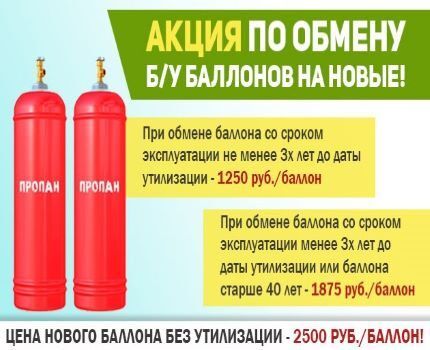
The main motives for opening old containers on your own are the use of empty containers for household purposes and scrap metal. Experts advise abandoning such ideas or using the help of professionals. The main thing is to remember that a solid cylinder is never completely free of the gas mixture.
An excellent solution is to hand over the cylinder to a private service company. As a rule, their prices significantly exceed the benefits of scrapping the container. An additional bonus is pickup, when representatives of the organization go to pick up the equipment at the specified address.
Conclusions and useful video on the topic
In order not to make a mistake when choosing, you can focus on the color of the container. To connect to a gas stove, use red cylinders with white inscription:
The most popular composition used to fill household cylinders is a mixture of propane and butane. Correctly selected proportions allow you to effectively use the physical properties of both substances.
Please note that a cylinder with an inscription that does not meet the requirements must be removed from service. Any attempts to paint over or change the name are a violation of the rules.
Maybe you have useful experience using cylinders for a gas stove, are you well versed in the composition, or have you ever managed to notice a leak in time? Write about it in the comments. Your experience may be invaluable to other users.



